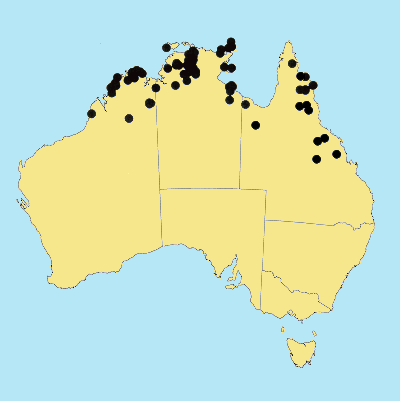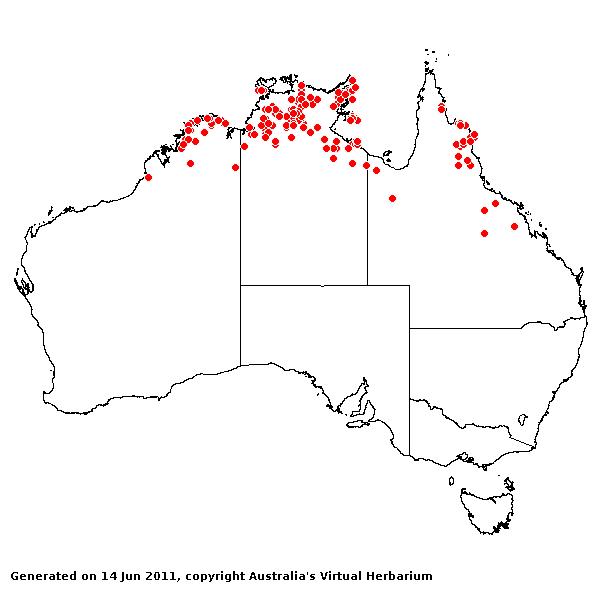Triodia microstachya R. Br. Prodr.
182 (1810).
Classification. (GPWG 2001) : Subfamily Chloridoideae. Triodeae.
Type of Basionym or
Protologue Information: Northern Territory: Darwin & Gulf District;
North Coast, Cotton Is. (The English Company's Islands), 20 Feb 1803, R.
Brown [6255] (HT: BM; IT: CANB, E, PERTH (photo BM)).
Key references
(books and floras): [1810]. R.Brown, Prodromus (182), [1878]
G.Bentham, Flora Australiensis 7 (607), [2002] D.Sharp & B.K.Simon, AusGrass,
Grasses of Australia.
Habit.
Perennial. Stolons present. Culms 30–250 cm tall. Leaf-sheaths glabrous on
surface. Ligule a fringe of hairs. Leaf-blades curved or curled, aciculate,
flat or conduplicate, 60 cm long, 0.5–1.3(–4.5) mm wide.
Inflorescence.
Inflorescence compound, a panicle of racemes. Panicle 18–74 cm long, -8 cm
wide, contracted about primary branches.
Spikelets.
Spikelets pedicelled. Fertile spikelets many flowered, with at least 2 fertile
florets (3–4), comprising 3–4 fertile floret(s), with diminished florets at the
apex, oblong, laterally compressed or terete, 3–6 mm long.
Glumes. Glumes
similar, thinner than fertile lemma. Lower glume oblong, scarious, without
keels, 3 -nerved. Upper glume oblong, 2.3–3.5 mm long, scarious, without keels,
1–3 -nerved. Upper glume surface smooth.
Florets.
Fertile lemma 2–3.5 mm long, without keel or keeled, 3 -nerved. Lemma surface
glabrous or indumented. Lemma apex dentate or lobed, muticous. Anthers 3.
Continental
Distribution: Australasia.
Australian
Distribution: Western Australia, Northern Territory, Queensland.
Western Australia:
Gardner, Hall, Dampier. Northern Territory: Darwin & Gulf, Victoria
River. Queensland: Cook, Burke, North Kennedy, Leichhardt.
Notes.
Distinguishing characters include the robust resinous habit; large racemose
panicle with usually crowded spikelets; strongly nerved (especially lower)
glumes long relative to the small, few-flowered spikelet; mostly glabrous and
smooth floret; minutely lobed 3-nerved lemma; obovoid compressed caryopsis with
large embryo.
W.A.,
N.T. and Qld N of 20°S on mainland and coastal islands. Widespread and often
the dominant grass in deep or skeletal, sandy or yellow earth soils on rugged,
dissected often bouldery, sandstone plateaux, hills, ranges, ridges, mesas,
escarpments, ravines, gorges, creek valleys and massive outcrops; also
associated with quartzite, basalt, laterite and conglomerate, and found on
coastal sands and beach dunes, coastal pindan, salt lakes, in white alluvial
sand near creeks, and in rocky creek river beds; flowers Jan.-May, persisting
into June to Oct.



